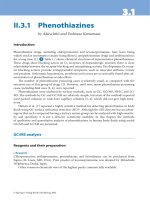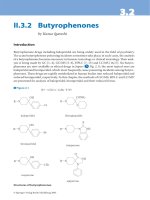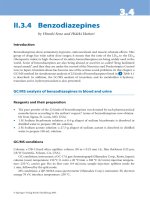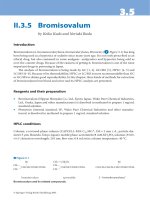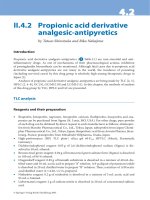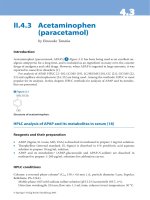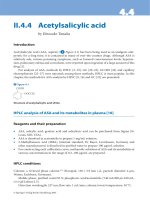Tài liệu Drugs and Poisons in Humans - A Handbook of Practical Analysis (Part 28) pptx
Bạn đang xem bản rút gọn của tài liệu. Xem và tải ngay bản đầy đủ của tài liệu tại đây (260.08 KB, 8 trang )
3.2
© Springer-Verlag Berlin Heidelberg 2005
II.3.2 Butyrophenones
by Kazuo Igarashi
Introduction
Butyrophenone drugs including haloperidol are being widely used in the eld of psychiatry.
e acute butyrophenone poisoning incidents sometimes take place; in such cases, the analysis
of a butyrophenone becomes necessary in forensic toxicology or clinical toxicology. eir anal-
ysis is being made by GC [1–4], GC/MS [5–6], HPLC [7–15] and LC/MS [16,17]. Six butyro-
phenones are now available as ethical drugs in Japan (
> Fig. 2.1); the most typical ones are
haloperidol and bromperidol, which most frequently cause poisoning incidents among butyro-
phenones. ese drugs are rapidly metabolized in human bodies into reduced haloperidol and
reduced bromperidol, respectively. In this chapter, the methods of GC/MS, HPLC and LC/MS
a
are presented for analysis of haloperidol, bromperidol and their reduced forms.
Structures of butyrophenones.
⊡ Figure 2.1
264 Butyrophenones
GC/MS analysis
Reagents and their preparation
• Haloperidol can be purchased from Sigma (St. Louis, MO, USA) and other manufacturers;
bromperidol, reduced haloperidol and reduced bromperidol from Research Biochemical
International (Natick, MA, USA).
• A 4-g aliquot of NaOH and 6 g NaCl are dissolved in distilled water to prepare 100 mL
solution (1 M NaOH solution)
b
.
• n-Hexane/isopropanol (95:5, v/v) mixture solution
• 0.1 M Hydrochloric acid solution
• As internal standard (IS)
c
, bromperidol (500 ng/mL in 0.1 M hydrochloric acid solution) is
used for analysis of haloperidol, and vise versa.
• Preparation of standard solutions: haloperidol or bromperidol solutions at 2–50 ng/mL in
0.01 M hydrochloric acid are prepared, and each 2-mL aliquot is placed in a 15-mL volume
glass centrifuge tube with a ground-in stopper.
GC/MS conditions
Instrument: an Agilent 5890 GC instrument (Agilent Technologies, Palo Alto, CA, USA) con-
nected with a JEOL Automass quadrupole mass spectrometer (JEOL, Tokyo, Japan).
GC column: an HP-5 fused silica capillary column (30 m × 0.32 mm i. d., lm thickness
0.25 µm, Agilent Technologies); column (oven) temperature: 100 °C (1 min) → 30 °C/min →
270 °C (30 s) → 5 °C/min → 290 °C (5 min); injection temperature: 260 °C; separator tempera-
ture: 280 °C; carrier gas: He; its ow rate: 1.5 mL/min; MS ionization mode: EI; electron energy:
70 eV; detector voltage: 750 V; ion source temperature: 280 °C.
Procedure
d
i. A 2-mL volume of urine or blood, 0.05 mL IS and 0.5 mL of 1 M NaOH are placed in a 15-mL
volume glass centrifuge tube with a ground-in stopper and mixed well, followed by addi-
tion of 6 mL of the mixture of n-hexane/isopropanol and its shaking for 20 min.
ii.
A er centrifugation at 600 g for 5 min, 5.5 mL of the upper organic layer is transferred to
another 15-mL volume glass centrifuge tube, followed by the addition of 1.5 mL of 0.1 M
hydrochloric acid solution and vigorous shaking for 20 min.
iii.
A er centrifugation at 600 g for 5 min, the upper organic layer is discarded; the aqueous phase
is again washed with 1 mL of the mixture of n-hexane/isopropanol by shaking it for 30 s.
iv. A er centrifugation at 600 g for 5 min, 1.2 mL of the lower aqueous phase is transferred to a
10-mL volume glass centrifuge tube with a ground-in stopper, followed by addition of 0.2 mL
of 1 M NaOH and 1 mL of the n-hexane/isopropanol mixture, and vigorous shaking for 30 s.
v.
A er centrifugation at 600 g for 5 min, the upper organic layer is transferred to a small
glass test tube and evaporated to dryness.
vi. e residue are dissolved in 20 µL ethanol.
265
vii. For quantitation, the selected ion monitoring (SIM) mode of GC/MS is employed using
ions at m/z 224 for haloperidol and m/z 268 for bromperidol; peak area ratios of haloperi-
dol or bromperidol to IS are plotted against various concentrations of the test compound
spiked to blank blood or urine to draw a calibration curve. A peak area ratio of a test
specimen is applied to the calibration curve to calculate its concentration.
Assessment of the method
e butyrophenone drugs analyzable by GC or GC/MS in the underivatized forms are halo-
peridol, bromperidol, moperone and oropipamide; but for timiperone and spiperone, satis-
factory peaks cannot be obtained.
TICs and SIM chromatograms of haloperidol, bromperidol and their reduced forms are
shown in
> Fig. 2.2. e detection limit was about 10 pg in an injected volume for both halo-
peridol and bromperidol; the recoveries were also excellent. e separation ability of GC or
GC/MS is much superior to that of HPLC or LC/MS.
HPLC and LC/MS analysis
Reagents and their preparation
e sources for acquisition of haloperidol, bromperidol and their reduced forms is the same as
described in the GC/MS section.
TICs and SIM chromatograms by GC/MS for the authentic standards of butyrophenone drugs
(100 ng/mL each) (A) and for a serum extract from a poisoned patient (B). m/z 224: haloperidol
(HP) and reduced haloperidol (RHP); m/z 268: bromperidol (BP, IS) and reduced bromperidol (RBP).
⊡ Figure 2.2
HPLC and LC/MS analysis
266 Butyrophenones
HPLC analysis
Instrument: an SPD-M10A photodiode array detector ( DAD), a CTO-10A column oven, an
SIL-10A autosampler and an LC-10AD pump system (all from Shimadzu Corp., Kyoto, Japan).
HPLC conditions; column : Cosmosil 5CN-MS (150 × 4.6 mm i. d., particle diameter 5 µm,
Nacalai Tesque, Kyoto, Japan; mobile phase: acetonitrile/methanol/20 mM ammonium acetate
aqueous solution/triethylamine (20:25:55:0.1, v/v, to be adjusted to pH 4.7 with phosphoric acid);
ow rate: 1.0 mL/min; column (oven) temperature: 40 °C; detection wavelength: 220 nm.
LC/MS analysis
Instrument: a 2690 Alliance HPLC pump system (Waters, Milford, MA, USA) connected with a
Micromass Quattro Ultima desktop quadrupole MS-MS instrument (Micromass, Manchester,
UK)
LC/MS conditions; column: Cosmosil 5CN-MS (150 × 4.6 mm i. d., particle diameter
5 µm, Nacalai Tesque); mobile phase: methanol/20 mM ammonium formate aqueous solution
(60:40, v/v); ow rate: 0.6 mL/min; column (oven) temperature: 40 °C; interface: electrospray
ionization ( ESI); ion source temperature: 120 °C; temperature for removing solvent: 350 °C;
gas for removing solvent: 600 L/h; spray (cone) voltage: 35 eV.
Procedure
i. e procedure i–v described in the GC/MS analysis section is followed for a urine or blood
specimen to obtain a residue containing butyrophenones. e residue is dissolved in 0.1 mL
of the mobile phase of HPLC or LC/MS.
ii. For HPLC-DAD and LC/MS, 50 and 20 µL of the above solution are injected, respec -
tively.
iii. For the SIM of LC/MS, the ions at m/z 376, 378 and 422 are used for detection of halo-
peridol, reduced haloperidol and bromperidol, respectively.
iv. For both HPLC and LC/MS, bromperidol is used as IS for quantitation of haloperidol, and
vice versa.
v. For both HPLC and LC/MS, the peak area ratio of a test compound to IS obtained from a
test specimen is applied to a calibration curve constructed in advance to calculate the con-
centration of the test compound.
Assessment of the methods
> Figure 2.3 shows chromatograms for haloperidol, reduced haloperidol and bromperidol
(IS) obtained by HPLC-DAD. e optimum detection wavelength was 220 nm; when meas-
ured at 250 nm, reduced haloperidol could not be detected. e detection limit obtained by
HPLC-DAD was about 5 ng in an injected volume for all compounds.
HPLC-DAD is advantageous over HPLC-UV in that the sensitivity can be enhanced by
measuring a target compound at the wavelength of its absorbance maximum, or by shi ing the
267
wavelength from its maximum to avoid impurity peaks. Also by measuring an absorbance
spectrum of a compound, it is possible to make tentative identi cation.
By LC/MS analysis, the sensitivity and speci city are much higher. Distinct peaks of all
compounds appear (
> Fig. 2.4); the detection limit by LC/MS was about 2 pg in an injected
volume.
For sensitive analysis of timiperone and spiperone with relatively high molecular weights,
LC/MS may be most suitable.
Poisoning cases, and toxic and fatal concentrations
A 2-year plus 5 month-old female and an 11-month-old male [18] had ingested 265 mg
haloperidol in total (combined amount for both children); both were brought to a hospital in
the comatose state and showed bradycardia, hypotension and sinus arrhythmia. Mannitol was
injected into the female child intravenously; though the consciousness was gradually recovered
24 h a er admission, neurological symptoms, such as tremor, muscle sti ness and dyskinesia
of the face, appeared. us, diphenhydramine was injected into her intravenously; she recov-
ered 4 days a er admission. For the male baby, similar treatments, such as intravenous injec-
tion of mannitol and diphenhydramine, were carried out, but the neurological symptoms were
not improved easily; it took as long as 7 days for his recovery.
erapeutic and toxic blood levels of haloperidol were reported to be 5–40 and 50–100 ng/
mL, respectively; therapeutic blood levels of bromperidol 2–20 ng/mL [19]. erapeutic and
toxic blood levels of oropipamide were reported to be 0.1–0.4 and 0.5–0.6 ng/mL, respec-
tively [20].
HPLC-DAD chromatograms for the authentic haloperidol (HP) and reduced haloperidol (RHP)
(100 ng/mL each) (A) and for a serum extract from a poisoned patient (B).
⊡ Figure 2.3
Poisoning cases, and toxic and fatal concentrations
